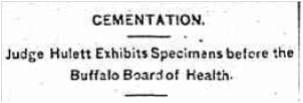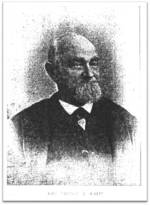By Michelle Ann Kratts
This article appeared in NiagaraHub.com
He spent his boyhood by the light of tallow candles, pouring over whatever books he could get his hands on. He was mechanical by nature. Never satisfied. Always seeking more knowledge and that light in the darkness. Born into meager circumstances on June 13, 1811, in Williamsburgh, Massachusetts, Theodore Graves Hulett left home at twelve years old to apprentice with a carriage manufacturer in Pittsfield. He taught himself law on the side and eventually made his way to Niagara Falls by 1834. An important man, he was superintendent of the first Suspension Bridge and constructed the famous iron basket which, at one time, was the only means of transportation between the United States and Canada at this point until the bridge was created. It was suspended on a cable that ran along the American and Canadian shores. He was so confident in its durability that he sent his own daughter across on its maiden voyage—never imagining for a moment the possibility that it could tumble down into the gorge taking little Elvira to a most violent death. In 1849, Hulett was elected Justice of the Peace of the town of Niagara. He was extremely active in most public matters in Niagara Falls and was one of our most prominent and respected residents. During the Civil War he took care of the soldiers and their families. But there was one more thing about Judge Hulett. It was probably one of the most unusual contributions anyone ever made to Niagara Falls. He originated the idea of and practiced (in Oakwood Cemetery) the cementation of the dead.
We’re not sure exactly how many graves and individuals were cemented as records are sparse during this time period. We do know that the “cementation of the dead” was pretty common practice after 1886—but only in Oakwood Cemetery. It was the only cemetery in the world to carry out such an unusual manner concerning the disposal of the dead. According to a Niagara Gazette article on August 31, 1886, “this mode of burial has become the rule in Oakwood Cemetery.” It cost the families an additional fee of $15 “to cement a casket in a stone casing of eight inches in thickness and without a royalty as it was under a scientist’s patent.” Apparently, “on account of the moisture in the ground…” Oakwood Cemetery was the perfect location for the cementation of the dead.
It was on June 4, 1874, that Judge Hulett first obtained some frogs, prepared a cement mixture and cemented the frogs into stone blocks. He did the same with a pear. Five years later he sawed them open and found the most amazing thing had occurred! The watery portions of the once living material had been absorbed by the stone, leaving the tissues intact and a perfect cast of the original. Even much of the original colors remained. He kept these specimens on exhibition in his office for many years. It was in 1874 that he wrote out his last will and testament in which he gave specific orders for the cementation of his own body.

In 1886, before the Sanitary Board in Buffalo, Judge Hulett declared that “he had decided to cement all his family.” His two daughters feeling the cementation of their bodies would be “pretty close quarters” requested that only their coffins be encased in cement to the thickness of a foot. Each box weighed two tons. Others would have three inches of cement placed in their coffin and allowed to harden. At this point the embalmed nude body would be laid upon the foundation and the coffin filled with cement until the body was three inches below the surface. The graves dug for the cementation process would be much deeper in order to receive the casket. More cement would be poured over the lowered casket and fine sulphur and powdered charcoal with alcohol would then be placed between the outer case and the casket and then set on fire. The lid would then be screwed on. This process would ensure that all liquids in the body be absorbed and the gases from the dead body neutralized. It was believed that the cementation of the dead would secure the body from the attacks of grave robbers. Or perhaps from something more sinister than grave robbers…
The first cementation of a body in Oakwood Cemetery occurred in January of 1887. David Hulett Thomas, a relative of Judge Hulett, after having been mysteriously killed in the railroad yards, was the first to be buried by the unique process. Representatives from the IOOF (Independent Order of Odd Fellows) and the fire companies of Niagara Falls, New York, and Niagara Falls, Ontario, of which the deceased was a member, attended in great numbers--so did representatives of the Health Department, various scientific organizations from around the state and the general public. Following the burial of David Thomas, many of Niagara’s dead were buried in the same fashion in Oakwood Cemetery.
The cementation of the dead in Oakwood Cemetery was Judge Hulett’s one last obsession in his twilight years. He was the founder and president of the American Cementation Society, which was established in Buffalo, and the editor of “the Cemetarian,” a monthly newsletter concerning topics relating to the “cementation of the dead.” Upon his death, on April 13, 1907, Hulett left explicit instructions for the disposal of his own body. He greatly preferred “Portland Cement” over all others “as long as it can be obtained at a reasonable price.” A Unitarian, he requested that a Universalist minister be present for the service but if that was not available “any clergyman or layman” may do as long as he leads in a favorite hymn by Cowper. Perhaps the strangest part of his Hulett’s request was the simplest. He asked that the only “representative” of his body at the funeral be his “easy chair, empty,” his “cane and boots lying in the chair” and his “grand and great grand children standing (or sitting) around the chair and other friends standing or sitting around in an outer circle…”
You can visit Theodore Graves Hulett’s final resting place at Oakwood Cemetery. I go there often and attempt to understand his obsession with making sure the dead would not rise again. My mind reaches back into those dark Victorian times in Niagara Falls and wonders if it had to do with a strange event that occurred in July of 1866 in the yards of the Central Railroad, near the Suspension Bridge. The event caused much excitement and certainly piqued the wild imagination of Niagara’s residents. Newspapers across the nation became interested in the reports that 60-70 sheep had been found killed, in most unusual circumstances over a few days’ time near Niagara Falls. Even as these animals commonly roamed freely throughout the village an occurrence such as this was most startling for the fact that “the sheep were merely bitten in the neck and the blood sucked from the carcass.” No other damage had been done to their bodies. A posse was formed and men with torches were sent out to search for the guilty varmints. Outwardly, it was supposed that a wolf had been the culprit, although it had been believed that the last remnants of wolves had been eradicated years before. The culprit was never discovered although it seems possible that the villagers felt a supernatural presence had made itself known. The general public, at the time, was well aware of vampires and their proclivities. Even as Bram Stoker’s, Dracula, had yet to be written, the short story, “The Vampyre”, conceived by John Polidori, Lord Byron’s physician, in 1819, was popular literature throughout the United States. People will always be fearful of the unknown—and is it possible that this was the case in Niagara Falls? Hulett spent the rest of his life ensuring that the dead of Niagara Falls would rest in peace. Perhaps he knew what had happened to those sheep…perhaps he saw himself as a sort of pioneer “vampire hunter.” Whatever the answer, we will never know for certain; he has surely taken it to his cemented grave at Oakwood Cemetery.
